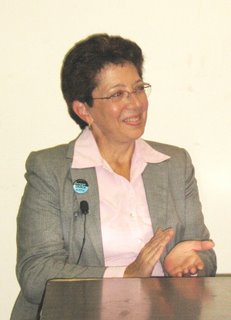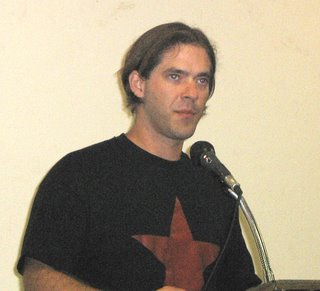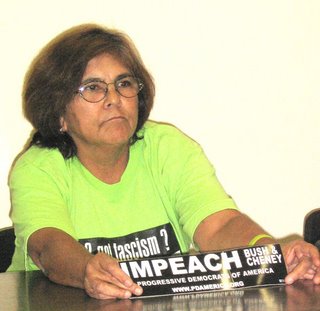



Top to bottom: Jeeni Criscenzo, Gloria Daviston, Michael Kuzart, Aïda Reyes.
Progressive San Diego Rallies for Impeachment
by MARK GABRISH CONLAN
Copyright © 2006 by Mark Gabrish Conlan for Zenger’s Newsmagazine • All rights reserved
“If we dwell on the negative and all the terrible things, we’ll give power to all the negative things and feel overwhelmed,” former Congressional candidate Jeeni Criscenzo told about 70 people at a Progressive San Diego event at the Joyce Beers Community Center in Hillcrest December 9. Though the announced topic of the forum was “presidential accountability,” it was obvious even before the speeches began that its real purpose was to build support for impeachment proceedings against President George W. Bush and Vice-President Dick Cheney.
All along the side walls of the room, volunteers sat at tables inviting people to sign petitions calling for impeachment. The tables also contained e-mail sign-ins so people could get on mailing lists and send online appeals to their Congressmembers urging that the House of Representatives begin impeachment proceedings against Bush and Cheney. A yellow leaflet handed to all attendees listed 10 grounds for impeachment, including the war in Iraq, the torture of captives in Iraq and Afghanistan, arbitrary detentions of persons (including U.S. citizens) without due process, the recently passed Military Commissions Act that denied the right of habeas corpus to anyone detained by the government as an “enemy combatant,” and the Bush administration’s negligence and failure to respond to warnings of an impending al-Qaeda attack in 2001 and Hurricane Katrina in 2005.
The event’s opening speaker and MC, Judy Hess of Progressive Democrats of San Diego, made the agenda clear in her initial remarks. “When we impeach Bush and Cheney,” she said, “Nancy Pelosi will become president of the United States.” Acknowledging that Pelosi and other Democratic leaders slated to take over Congress in January have said that impeachment is “off the table,” Hess said that the purpose of the meeting — and of similar events taking place nationwide — was to build a groundswell of popular support for impeachment that will prevent the Democrats in Congress from continuing to duck the issue.
What will turn the tide and make impeachment feasible, Hess explained, is the promise of Democratic leaders in Congress to hold hearings and conduct investigations of Bush’s and Cheney’s policies and conduct. Through Bush’s first six years in office, the Republican Congressional majorities had basically given him a free pass. Not any more, said Hess: “Rigorous investigations will reveal wrongdoing. The facts and truth will be on the table, and put impeachment back on the table. Our children must be taught that you cannot subvert the Constitution and get away with it. We all have the power to give political cover to our Congresspeople.”
Hess explained that the impeachment campaign’s goal is to collect one million signatures nationwide by the end of December. “As they do investigations, our Congressmembers will have those signatures at their backs,” she said. “We are working to form grass-roots impeachment committees in every Congressional district in the country. Our desire is to let our Congressmembers know they have popular support as they do the right thing.”
“We are not looking at impeachment as a form of vengeance,” Criscenzo, the first speaker, said at the start of her talk. “We have a vision of what our country could be and Bush is standing in the way. Global warming, our standing in the world, and the budget are all on the precipice. We started by electing Democrats [to a Congressional majority] and we have to hold their feet to the fire and remind them of why we elected them. Number one is to get out of Iraq. In October, Congress approved $70 billion for Iraq. This spring Congress will be voting for $160 billion more, enough money to keep U.S. troops in Iraq until George W. Bush’s term ends — and the Democratic leaders are telling their members, ‘Don’t stand in the way of that appropriation.’”
Despite the wide-ranging agenda in the call for impeachment issued at the meeting, most of the presentations focused on the war in Iraq and the so-called “war on terror.” Criscenzo grimly noted that in August she’d met with officials from the Iraqi government and survivors of torture at Abu Ghraib. The meeting took place in Amman, Jordan one month after the Iraqi leaders had held a “unity summit” in Cairo, Egypt. According to Criscenzo, that’s one telling indicator of the failure of Bush’s war: the Iraqi government, supposedly democratically elected under U.S. auspices, can’t even hold meetings in its own country because life is so dangerous for them there.
Criscenzo said she went to that meeting in Amman convinced that Iraq’s partition into Shi’ite Arab, Sunni Arab and Sunni Kurd states was inevitable — but meeting with the Iraqi leaders changed her mind. “They came back from Egypt with a reconciliation plan and nothing had to do with greed, hatred or power-grabbing,” she recalled. “They said, ‘Don’t partition Iraq,’ because that would condemn them to eternal warfare. We had Sunni and Shi’a sitting next to each other, and they said, ‘We’re friends. We’re neighbors. We’ve lived together for hundreds of years.’”
According to Criscenzo, the Iraqis themselves want the war to end. Who wants it to continue? “Defense contractors are making a killing in Iraq, and they don’t want it to end,” she said. “Congressmember Dennis Kucinich said that 500,000 barrels a day of Iraq’s oil are being stolen. Nothing else works in Iraq, but the oil is being pumped without the meter running.” Criscenzo claimed that U.S. oil companies are draining Iraq’s oil reserves and “pumping nonstop,” partly to make as much money as they can in a hurry without having to pay anything back to the Iraqi people, and partly to realize their long-held dream of breaking the OPEC cartel and the hold OPEC’s largest producer, Saudi Arabia, has over world oil prices.
“The Bush administration has committed war crimes and crimes against humanity,” said Aïda Reyes of the World Can’t Wait organization, which held a mass event in downtown San Diego October 5 as part of an international mobilization. “Over 650,000 Iraqi civilians have been killed. The U.S. has taken over thousands of prisons in Iraq and tortured people. It has killed people with chemical weapons like white phosphorus. Every day we stay in Iraq is a living hell for the Iraqi people. The U.S. has spread 100 times as much radioactivity in Iraq than it used in Japan at the end of World War II [presumably a reference to the routine use of depleted-uranium ammunition by U.S. troops in both Gulf Wars], and the half-life of this material is 100 million years.”
Quoting British playwright Harold Pinter’s comment that “the Bush administration is the most dangerous force in the world’s history,” Reyes added that if the American people allow Bush and Cheney to serve out their terms, “We will be remembered as the people that allowed the atrocities to happen. Iran will be next, and then Venezuela. Will we be the people that allowed all forms of torture to be legal? Will we be the people that allowed habeas corpus to be revoked? The ‘war on terror’ is the rubric under which the Bush administration demanded and got increasing state power. Bush is not stupid. This was a plan at least two decades old to remake the world, and they used 9/11 as the pretext to do it.”
As she had done at the October 5 World Can’t Wait action, which she M.C.’d, Reyes ridiculed fellow progressives who put their faith in the electoral process in general and the Democratic party in particular. “There’s no indication that the new Congress will stop the Bush agenda,” she said. “The only force that will stop it is the people, millions of us. Our sentiments will not be felt until we form a mass movement of millions. The government didn’t listen to the protests, but the world listened and saw there was a section of people in this country who knew the war was unjust. It opened up more room for people to think and take a stand. As the lies were exposed and Iraq descended into unwinnable civil war, Bush’s popularity dropped from 80 percent to 30 percent.”
Perhaps the most powerful speaker on the program was Michael Kuzart, a recent veteran of the “war on terror” and a member of Iraq Veterans Against the War. He said he knew that there would be a U.S. attack on Iraq as early as June 2002, when he was based in Qatar and involved in sending military supplies to Afghanistan. “Then I was moved to another equipment supply store so we would have material ready in case there was another war in the Middle East,” Kuzart said. “I started to turn away from the war in June 2002, when I noticed a lot of equipment was accumulating in Kuwait. I had a bad feeling, and when I went home on leave and heard all this stuff about Saddam Hussein supposedly having weapons of mass destruction, I knew that we were going to invade Iraq.”
Kuzart recalled the 13 days of what he called “cakewalk duty” he served in Afghanistan. “I volunteered to help out the civil affairs unit,” he said. “We would go to villages where there had just been fighting, and I would wait outside with the vehicles while the officers would go in, negotiate and pay off the warlords. Now there’s more violence in Afghanistan because the warlords would rather spend money on weapons than on rebuilding schools. This was the first time civil-affairs units would go in on missions with active-duty soldiers, and we got medals for it, but it was really a drive-through reparations program. There was no intent to rebuild Afghanistan.”
One of Kuzart’s main motivations for joining the impeachment effort was to see President Bush held accountable for the lies he told to win U.S. support for the “war on terror” and the attack on Iraq. “I don’t think the President should be allowed to lie to us,” he said. “We’re told the women in Afghanistan don’t have to wear burkas anymore, but during the time I was there I never saw a woman’s face.”
“Raise your hand if you knew about the $55 million contract to Kellogg, Brown and Root [a subsidiary of Halliburton] for constructing detention camps in the U.S.,” said Hess, who took the podium at this point to introduce a videotaped presentation by National Lawyers’ Guild president and Thomas Jefferson School of Law professor Marjorie Cohn. “There is a U.S. Army Rapid Action Deployment System for civilian detention on unused Army basis in the U.S. It says it’s for civilians to be in those camps, labor camps or detention camps. It says ‘persons of note’ should be held there.”
Cohn’s taped presentation had been filmed on December 6 at a Progressive Democrats of America event in Clairemont. She discussed the Military Commissions Act and a potentially even more far-reaching law, the John Warner Defense Authorization Act, passed by Congress and signed into law by President Bush the same day: October 17, 2006. “The Military Commissions Act allows the President to declare anyone, including U.S. citizens, ‘unlawful enemy combatants’ and detain them indefinitely,” Cohn said. “It’s so broadly defined that anyone who donates to a charity that turns up on Bush’s list of ‘terrorist organizations,’ or speaks out against government policies, could be declared an ‘enemy combatant’ and lose habeas corpus rights.”
The Defense Authorization Act allows the President, solely on his own authority, to declare martial law and put the National Guard units of the various states under federal command “to restore public order and defend the United States.” While the ostensible purpose of this act is to give the President power to respond to another 9/11-style attack on the U.S., Cohn warned that under its language, otherwise legal, peaceful protest could be used as a pretext for martial law and the establishment of a Presidential dictatorship.
“In a November 2006 speech at the Air Force Academy, Attorney General Alberto Gonzalez warned that anyone who says Bush’s surveillance program stifles freedom ‘poses a grave threat to the liberty and security of the American people,’” Cohn said. “Documents obtained by the American Civil Liberties Union show that military officials labeled anti-war and anti-recruitment demonstrations as ‘threats to the national security.’”
Cohn drew a parallel between the Military Commissions Act, the Defense Authorization Act and the USA PATRIOT Act and earlier attempts by the U.S. government to suppress political dissent, including the Alien and Sedition Acts of 1798 and the “extensive surveillance” of the so-called McCarthy era in the late 1940’s and 1950’s. She also pointed out that the U.S. Supreme Court’s 1944 decision ruling that the government had the power to order all Japanese-Americans into internment camps is still on the books — and quoted then-Supreme Court Justice Robert Jackson, who in his original dissent in the case warned that the court’s ruling would be available to any future government that wanted to set aside the Constitution to punish American citizens and legal residents for arbitrary reasons.
The final speaker at the event was Gloria Daviston from San Diego Veterans for Peace, a local chapter of a national organization which called for impeaching Bush and Cheney as early as 2002. She joined the Army at 19 and served seven and one-half years during the Viet Nam era, and talked about how the military appeals to young people to get them to join — and then lets them down. “The call goes out to them to ‘be all you can be’ and do their patriotic duty, and they expect the military to do right by them,” Daviston said. “Under Bush, that has not happened. They have been misused and abused.”
Daviston spoke in support of war resisters like Lieutenant Ehren Watada, who is scheduled to be court-martialed in January for refusing an order to deploy to Iraq — the first commissioned officer to do so. She said the evils of the Bush administration started “when he hijacked the election in 2000” — one of the items in the bill of particulars against him and Cheney in the event’s leaflet — “and it’s been downhill ever since: the breaking of the Geneva conventions, the threats on Iran, the degradation of the United States Constitution. The Bush administration has committed unconscionable acts, and we must speak out. A dalliance with Monica Lewinsky is not an impeachable offense; Bush’s acts are.”
